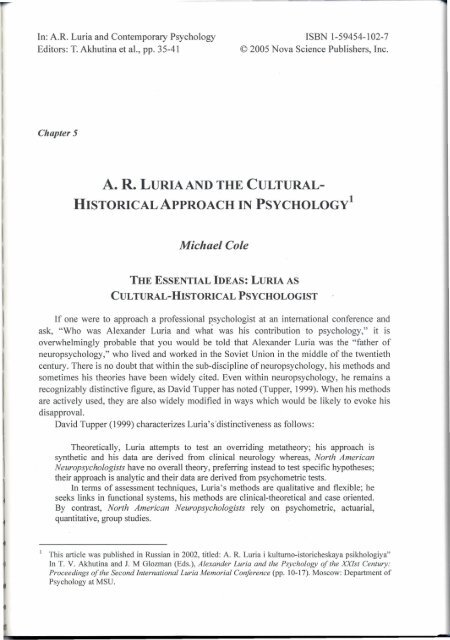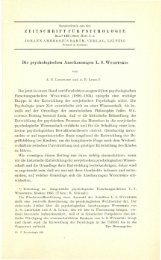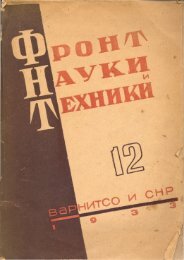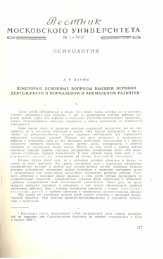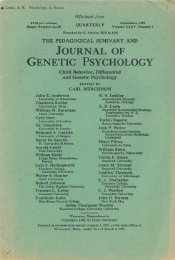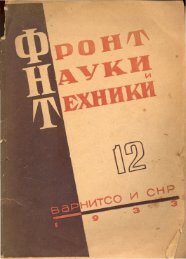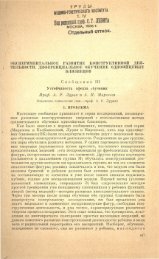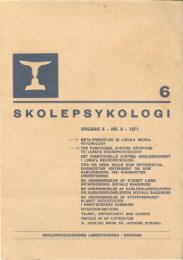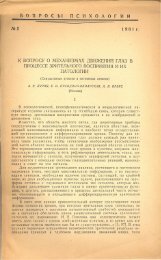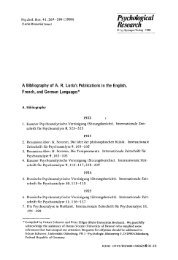A. R. Luria and the Cultural-Historical Approach in Psychology
A. R. Luria and the Cultural-Historical Approach in Psychology
A. R. Luria and the Cultural-Historical Approach in Psychology
Create successful ePaper yourself
Turn your PDF publications into a flip-book with our unique Google optimized e-Paper software.
In: A.R. <strong>Luria</strong> <strong>and</strong> Contemporary <strong>Psychology</strong>Editors: T. Akhut<strong>in</strong>a et aI., pp. 35-41ISBN 1-59454-102-7© 2005 Nova Science Publishers, Inc.Chapter 5A. R. LURIA AND THE CULTURAL-HISTORICAL ApPROACH IN PSYCHOLOGY!MichaelColeTHE ESSENTIALIDEAS: LURIA ASCULTURAL- HISTORICAL PSYCHOLOGISTIf one were to approach a professional rsychologist at an <strong>in</strong>ternational conference <strong>and</strong>ask, "Who was Alex<strong>and</strong>er <strong>Luria</strong> <strong>and</strong> what was his contribution to psychology," it isoverwhelm<strong>in</strong>gly probable that you would be told that Alex<strong>and</strong>er <strong>Luria</strong> was <strong>the</strong> "fa<strong>the</strong>r ofneuropsychology," who lived <strong>and</strong> worked <strong>in</strong> <strong>the</strong> Soviet Union <strong>in</strong> <strong>the</strong> middle of <strong>the</strong> twentiethcentury. There is no doubt that with<strong>in</strong> <strong>the</strong> sub-discipl<strong>in</strong>e of neuropsychology, his methods <strong>and</strong>sometimes his <strong>the</strong>ories have been widely cited. Even with<strong>in</strong> neuropsychology, he rema<strong>in</strong>s arecognizably dist<strong>in</strong>ctive figure, as David Tupper has noted (Tupper, 1999). When his methodsare actively used, <strong>the</strong>y are also widely modified <strong>in</strong> ways which would be likely to evoke hisdisapproval.David Tupper (1999) characterizes <strong>Luria</strong>'s'dist<strong>in</strong>ctiveness as follows:Theoretically, <strong>Luria</strong> attempts to test an overrid<strong>in</strong>g meta<strong>the</strong>ory; his approach issyn<strong>the</strong>tic <strong>and</strong> his data are derived from cl<strong>in</strong>ical neurology whereas, North AmericanNeuropsychologists have no overall <strong>the</strong>ory, preferr<strong>in</strong>g <strong>in</strong>stead to test specific hypo<strong>the</strong>ses;<strong>the</strong>ir approach is analytic <strong>and</strong> <strong>the</strong>ir data are derived from psychometric tests.In terms of assessment techniques, <strong>Luria</strong>'s methods are qualitative <strong>and</strong> flexible; heseeks l<strong>in</strong>ks <strong>in</strong> functional systems, his methods are cl<strong>in</strong>ical-<strong>the</strong>oretical <strong>and</strong> case oriented.By contrast, North American Neuropsychologists rely on psychometric, actuarial,quantitative, group studies.1 This article was published <strong>in</strong> Russian <strong>in</strong> 2002, titled: A. R. <strong>Luria</strong> i kulturno-istoricheskaya psikhologiya"In T. V. Akhut<strong>in</strong>a <strong>and</strong> J. M Glozman (Eds.), Alex<strong>and</strong>er <strong>Luria</strong> <strong>and</strong> <strong>the</strong> <strong>Psychology</strong> of <strong>the</strong> XXIst Century:Proceed<strong>in</strong>gs of <strong>the</strong> Second International <strong>Luria</strong> Memorial Conference (pp. 10-17). Moscow: Department of<strong>Psychology</strong> at MSU.
•36 Michael ColeThese contrasts po<strong>in</strong>t squarely at <strong>the</strong> fact that <strong>Luria</strong> was, from <strong>the</strong> beg<strong>in</strong>n<strong>in</strong>g, work<strong>in</strong>g <strong>in</strong>a different scientific paradigm than his North American (<strong>and</strong> many o<strong>the</strong>r) colleagues.My own view is that <strong>Luria</strong> was an extraord<strong>in</strong>arily broad <strong>and</strong> ambitious psychologicalth<strong>in</strong>ker for whom neuropsychology was one, but only one, of many sub-fields to which hemade important contributions over a career that lasted more than 50 years. He identifiedhimself as a cultural-historical psychologist, as a follower of Lev Semyonovich Vygotsky,<strong>and</strong> a colleague of Alexey Leontiev, with whom he set out as a young man to create asyn<strong>the</strong>tic, all-embrac<strong>in</strong>g psychology. To underst<strong>and</strong> who <strong>Luria</strong> was, even if one is only<strong>in</strong>terested <strong>in</strong> his contributions to neuropsychology, it is necessary to underst<strong>and</strong> him first <strong>and</strong>foremost as a cultural-historical psychologist, a dist<strong>in</strong>ctive paradigm that has ga<strong>in</strong>ed manyadherents world-wide s<strong>in</strong>ce <strong>Luria</strong>'s death a quarter of a century ago.80%D<strong>Cultural</strong><strong>Psychology</strong>70% • Development60%50%40%30%DLanguageD Neuropsychology20% D Self-Control10%0%1990 1991 1992 1993 1994 1995 1996 1997 1998 1999 20002001Figure 1. Summary comparison of <strong>Luria</strong>'s work.In <strong>the</strong> Figure, I present a statistical summary of references to <strong>Luria</strong>'s work <strong>in</strong> several keyareas of psychology dur<strong>in</strong>g <strong>the</strong> past decade. This graph is an underestimate of <strong>the</strong> totalnumber of articles by a large factor because it <strong>in</strong>cludes only cases where <strong>Luria</strong>'s nameappears ei<strong>the</strong>r as a title word, subject, or key word. You will note that even many years afterhis death, he cont<strong>in</strong>ued to be <strong>the</strong> subject of many articles <strong>and</strong> books, <strong>and</strong> cont<strong>in</strong>ues to bewidely cited. The predom<strong>in</strong>ance of neuropsychological references is self-evident, but so is <strong>the</strong>cont<strong>in</strong>ued importance of work written more than half a century ago <strong>in</strong> several different areasof psychology. These data leave little doubt about <strong>Luria</strong>'s broad <strong>in</strong>fluence on <strong>the</strong> field at <strong>the</strong>current time.In perhaps his last published article before his death, <strong>Luria</strong> himself tried to dist<strong>in</strong>guishbasic psychological approaches <strong>in</strong> order to establish what he considered characteristic of hisown approach (<strong>Luria</strong>, 1977):
A. R. <strong>Luria</strong> <strong>and</strong> <strong>the</strong> <strong>Cultural</strong>-<strong>Historical</strong> <strong>Approach</strong> <strong>in</strong> <strong>Psychology</strong> 37<strong>Approach</strong> 1: Human characteristics derive from genotypical codes <strong>and</strong> are essentiallyphysiological processes deriv<strong>in</strong>g from reflexes.<strong>Approach</strong> 2: Human consciousness develops from <strong>the</strong> nature of social processes, so <strong>the</strong>content of consciousness reflects social relations.<strong>Approach</strong> 3: <strong>Psychology</strong> is a biosocial science relat<strong>in</strong>g some human properties tobiological processes <strong>and</strong> o<strong>the</strong>rs to social processes.<strong>Approach</strong> 4: <strong>Psychology</strong> is a unique science that studies how new functional systemsreflect<strong>in</strong>g higher levels of conscious activity emerge from <strong>the</strong> <strong>in</strong>terpenetration of <strong>the</strong>social, cultural, <strong>and</strong> biological. Note that approach 4 is a rephras<strong>in</strong>g of <strong>the</strong> idea ofcultural-historical psychology.How THE BASIC IDEAS GREW AND CONTINUE TO GROW OVER TIMEIt is conventional, follow<strong>in</strong>g <strong>the</strong> format of <strong>Luria</strong>'s autobiography (<strong>Luria</strong>, 1979) <strong>and</strong>Homskaya's biography (Homskaya, 2001), to divide <strong>Luria</strong>'s career chronologically, as if hechanged topics at approximately 10 year <strong>in</strong>tervals. While this is a convenient way to organize<strong>the</strong> narrative of <strong>Luria</strong>'s work, it is my conviction that <strong>the</strong> topics never changed, even when <strong>the</strong>circumstances <strong>and</strong> particular content <strong>and</strong> correspond<strong>in</strong>g analytic strategies did change. If wetrace his ideas chronologically, but remember that early stages are modified <strong>and</strong> taken up <strong>in</strong>later stages, it is possible to underst<strong>and</strong> <strong>the</strong> cont<strong>in</strong>u<strong>in</strong>g relevance of <strong>Luria</strong>'s. ideas forcontemporary psychology.BASIC PRINCIPLES OF CULTURAL-HISTORICAL PSYCHOLOGY1. <strong>Cultural</strong> Mediation:a. The species-specific characteristic of humans is to live <strong>in</strong> <strong>the</strong> medi urn of culture,<strong>the</strong> residue of past human activity preserved <strong>in</strong> artifacts/tools/stimuli, broadlyconceived.b. Dist<strong>in</strong>ctively human (voluntary) behavior arises from <strong>the</strong> ability to create stimuli<strong>and</strong> to subord<strong>in</strong>ate oneself to <strong>the</strong>m <strong>in</strong> order to atta<strong>in</strong> goals.c. The idea of unmediated, "free" will power is a myth: "<strong>the</strong> human cannot bydirect force control his behavior any more than a shadow can carry stones"(<strong>Luria</strong>, 1932, page 6-7). In development, children come to learn to control<strong>the</strong>mselves "from <strong>the</strong> outside." This new syn<strong>the</strong>tic form is called <strong>the</strong> "culturalform of behavior."2. <strong>Historical</strong> Development:a. In addition to us<strong>in</strong>g <strong>and</strong> mak<strong>in</strong>g tools, human be<strong>in</strong>gs arrange for <strong>the</strong>rediscovery of <strong>the</strong> already-created tools <strong>in</strong> each succeed<strong>in</strong>g generation.b. Becom<strong>in</strong>g a cultural be<strong>in</strong>g <strong>and</strong> arrang<strong>in</strong>g for o<strong>the</strong>rs to become culturalbe<strong>in</strong>gs are <strong>in</strong>timately l<strong>in</strong>ked parts of a s<strong>in</strong>gle process called enculturation.c. Methodologically, m<strong>in</strong>d must be studied <strong>in</strong> <strong>the</strong> process of change at differentlevels of history (microgenesis, ontogenesis, cultural history, <strong>and</strong>phylogenesis), all of which are <strong>in</strong>tertw<strong>in</strong>ed.
•....38 Michael Cole3. Practical Activity:a. The analysis of human psychological functions must be grounded <strong>in</strong>everyday activities because (follow<strong>in</strong>g Marx) it is <strong>in</strong> practice that <strong>the</strong> dualityof materialism versus idealism could be superseded, <strong>and</strong> <strong>the</strong>representativeness of pr<strong>in</strong>ciples observed <strong>in</strong> artificial circumstances can beevaluated.b. Such activity must be studied both <strong>in</strong> terms of generaliz<strong>in</strong>g pr<strong>in</strong>ciples <strong>and</strong> <strong>in</strong>terms of <strong>in</strong>dividual lives: no generalization from <strong>in</strong>dividual cases, nogeneralization without <strong>in</strong>dividual cases.LURIA'S INITIAL STEPS: KNOWING OTHERS' THOUGHTSTHROUGH SELECTIVE DISCOORDINATION IN A CULTURAL MEDIUM<strong>Luria</strong>'s first major publication, The Nature of Human Conflicts, was published <strong>in</strong> <strong>the</strong>United States <strong>in</strong> 1932. The major portion of <strong>the</strong> book is devoted to his attempts to formulate amethod for discover<strong>in</strong>g what o<strong>the</strong>r people are th<strong>in</strong>k<strong>in</strong>g, objectively. In this work he applied amajor, overarch<strong>in</strong>g pr<strong>in</strong>ciple <strong>and</strong> a realization of this pr<strong>in</strong>ciple <strong>in</strong> a specific method.The pr<strong>in</strong>ciples can be termed <strong>the</strong> pr<strong>in</strong>ciple of systemic holism: "The structure of <strong>the</strong>organism presupposes not an accidental mosaic, but a complex organization of separatesystems ... [that] unite as very def<strong>in</strong>ite parts <strong>in</strong>to an <strong>in</strong>tegrated functional structure." (<strong>Luria</strong>,1932, pp. 6-7).He referred to <strong>the</strong> correspond<strong>in</strong>g method as The Comb<strong>in</strong>ed Motor Method: "We shouldon <strong>the</strong> one h<strong>and</strong>, produce <strong>the</strong> central process of <strong>the</strong> disorganization of behavior; on <strong>the</strong> o<strong>the</strong>rh<strong>and</strong>, we should try to reflect this process <strong>in</strong> some [o<strong>the</strong>r] system accessible <strong>and</strong> suitable forexam<strong>in</strong>ation. The motor function is such a systematic, objectively reflected structure of <strong>the</strong>neurodynamic processes concealed from immediate exam<strong>in</strong>ation. And <strong>the</strong>re lies before us <strong>the</strong>use of <strong>the</strong> motor function as a system of reflected structure of hidden psychological processes.Thus we proceed along <strong>the</strong> path we call <strong>the</strong> comb<strong>in</strong>ed motor method." (<strong>Luria</strong>, 1932, p. 18)The <strong>in</strong>itial motivation for <strong>the</strong> Comb<strong>in</strong>ed Motor Method was to f<strong>in</strong>d an objective approachto "hidden psychological processes" unavailable us<strong>in</strong>g Freud or Jung's methods. <strong>Luria</strong> used<strong>the</strong> method <strong>in</strong> field experiments with crim<strong>in</strong>als or suspected crim<strong>in</strong>als, students wait<strong>in</strong>g totake an exam<strong>in</strong>ation, whose right to study at <strong>the</strong> university was suspect, <strong>and</strong> experimentalanalyses us<strong>in</strong>g hypnotism. Without recogniz<strong>in</strong>g <strong>Luria</strong>'s contribution, o<strong>the</strong>rs have adopted thismethod which is widely used <strong>in</strong> <strong>the</strong> study of <strong>in</strong>fancy. For example, Jerome Bruner used itwhen he identified <strong>the</strong> "signature" suck<strong>in</strong>g response of newborns, <strong>and</strong> <strong>the</strong>y used variousstimulus conditions that might or might not disrupt it to determ<strong>in</strong>e <strong>the</strong> nature of <strong>the</strong>ir visualexperience (cf. Kaln<strong>in</strong>s & Bruner, 1973).Many <strong>in</strong>fancy researchers follow<strong>in</strong>g Bruner, us<strong>in</strong>g selective dis<strong>in</strong>hibition as a measure ofcognitive process<strong>in</strong>g, were also follow<strong>in</strong>g <strong>Luria</strong>'s methodological prescriptions withoutrealiz<strong>in</strong>g it.<strong>Luria</strong> also used <strong>the</strong> Comb<strong>in</strong>ed Motor Method <strong>in</strong> later work but because <strong>the</strong> work was notdeemed acceptable for publication <strong>in</strong> Russia until 2002, <strong>the</strong>re is little acknowledgement of it.<strong>Luria</strong> <strong>and</strong> Leontiev met Vygotsky while engaged <strong>in</strong> research on <strong>the</strong> comb<strong>in</strong>ed motor method.The most obvious l<strong>in</strong>kage with <strong>the</strong> early work <strong>in</strong> The Nature of Human Conflicts is to <strong>Luria</strong>'swork with mentally retarded children <strong>in</strong> <strong>the</strong> 1950's. The major issue <strong>in</strong> this later period was
A. R. <strong>Luria</strong> <strong>and</strong> <strong>the</strong> <strong>Cultural</strong>-<strong>Historical</strong> <strong>Approach</strong> <strong>in</strong> <strong>Psychology</strong> 39when word mean<strong>in</strong>g came to dom<strong>in</strong>ate stimulus strength <strong>in</strong> controll<strong>in</strong>g responses. Under <strong>the</strong>rubric of self-regulation this work cont<strong>in</strong>ues to have a broad <strong>in</strong>fluence on developmentalpsychologists <strong>and</strong> has led to extensive study of <strong>the</strong> role of parental verbal behavior <strong>in</strong>promot<strong>in</strong>g or retard<strong>in</strong>g mental development.PHYLOGENY AND ONTOGENYThe basic idea of cultural-historical psychology, that phylogeny <strong>and</strong> cultural-historymerge with <strong>the</strong> onset of language at <strong>the</strong> end of <strong>in</strong>fancy, was carried <strong>in</strong>to research withMironova <strong>and</strong> o<strong>the</strong>rs on identical <strong>and</strong> fraternal tw<strong>in</strong>s (<strong>Luria</strong> & Mironova, 1936). This verylarge project was perhaps <strong>the</strong> first to use <strong>the</strong> comparison of identical <strong>and</strong> fraternal tw<strong>in</strong>s as ameans of evaluat<strong>in</strong>g <strong>the</strong> role of phylogenetic factors <strong>in</strong> development, but most of it wentunpublished.This research depended critically on <strong>the</strong> belief that it is possible to create tasks thatselectively tap lower <strong>and</strong> higher psychological functions, a dist<strong>in</strong>ction which has beendifficult to ma<strong>in</strong>ta<strong>in</strong>. Current Russian research does not appear to pursue this approach.One positive result to come from this l<strong>in</strong>e of work was a fur<strong>the</strong>r illustration of <strong>the</strong> role ofspeech <strong>in</strong> develop<strong>in</strong>g <strong>in</strong>tellectual skills based on a case of two tw<strong>in</strong>s who developed a privatelanguage <strong>and</strong> <strong>the</strong>n underwent different forms of tra<strong>in</strong><strong>in</strong>g (<strong>Luria</strong> & Yudovich, 1956).CULTURAL HISTORY AND COGNITIVE DEVELOPMENTThe expeditions to Central Asia adopted virtually <strong>the</strong> opposite strategy of <strong>the</strong> researchwith tw<strong>in</strong>s, seek<strong>in</strong>g to determ<strong>in</strong>e if/how changes <strong>in</strong> culturally organized activity <strong>in</strong>fluenceddifferences <strong>in</strong> cognition with genetic endowment, at least at <strong>the</strong> group level, held constant.This work is widely cited <strong>in</strong> many fields <strong>and</strong> has rema<strong>in</strong>ed <strong>in</strong> pr<strong>in</strong>t for almost 30 years, but its<strong>the</strong>oretical <strong>in</strong>terpretation is controversial: Two major <strong>in</strong>terpretations of <strong>the</strong> results are widelydebated:1. <strong>Cultural</strong>-historical change causes development of shift from practical to <strong>the</strong>oreticalth<strong>in</strong>k<strong>in</strong>g.2. <strong>Cultural</strong>-historical change br<strong>in</strong>gs about activity-specific changes <strong>in</strong> modes ofthought.<strong>Luria</strong> himself favored <strong>the</strong> former conclusion <strong>in</strong> l<strong>in</strong>e with Marxist <strong>the</strong>ories which positclose connections between general stages of historical change <strong>and</strong> general modes ofcognition, <strong>and</strong> he is jo<strong>in</strong>ed <strong>in</strong> this conclusion by such em<strong>in</strong>ent scholars as Jerome Bruner(1996) <strong>and</strong> Jack Goody (1977). O<strong>the</strong>rs, such as myself (Cole, 1996) <strong>and</strong> Peeter Tulviste(1988), favor <strong>the</strong> latter <strong>in</strong>terpretation. The issue has yet to be decided, but <strong>the</strong>re is no questionthat <strong>Luria</strong>'s cross-cultural research rema<strong>in</strong>s highly <strong>in</strong>fluential <strong>and</strong> generative of new research.
40 Michael ColeNEUROPSYCHOLOGYThe <strong>the</strong>mes of earlier work became <strong>the</strong> foundation for a new k<strong>in</strong>d of neuropsychology,which cont<strong>in</strong>ues to have great <strong>in</strong>fluence. The key ideas familiar <strong>in</strong> a number of <strong>Luria</strong>'s bookson neuropsychology <strong>in</strong>clude:1. The notion of three major "blocks" of bra<strong>in</strong> function (energiz<strong>in</strong>g, cod<strong>in</strong>g, plann<strong>in</strong>g)<strong>and</strong> <strong>the</strong>ir organization <strong>in</strong>to functional systems.2. The idea that functional bra<strong>in</strong> systems <strong>in</strong>clude <strong>the</strong> culturally organized environmentas key constituents.3. The absolute methodological requirement to comb<strong>in</strong>e <strong>the</strong>ory <strong>and</strong> practice. In effect,successful re-mediation of bra<strong>in</strong> <strong>in</strong>juries becomes <strong>the</strong> acid test of <strong>the</strong>ory.Theoretically, <strong>the</strong> idea that cultural organization enters directly <strong>in</strong>to functional systems ofbra<strong>in</strong> organization have been given a huge boost by <strong>the</strong> work of Gerald Edelman on re-entrantmechanisms of cortical function<strong>in</strong>g (Edelman, 1995).At present, <strong>the</strong> need for a cross-cultural neuropsychology is seen as crucial fordevelop<strong>in</strong>g countries (Nell, 2000). This enterprise draws heavily on <strong>Luria</strong>'s cross-culturalwork, but also faces almost <strong>in</strong>superable <strong>in</strong>terpretive problems.ROMANTIC AND CLASSICAL SCIENCEIn his two short books about exceptional case studies, <strong>Luria</strong> gave voice to an entirely newgenre of scientific research which comb<strong>in</strong>es <strong>the</strong> nomo<strong>the</strong>tic <strong>and</strong> idiographic approaches thathave split psychologists s<strong>in</strong>ce <strong>the</strong> beg<strong>in</strong>n<strong>in</strong>g of <strong>the</strong> discipl<strong>in</strong>e, provid<strong>in</strong>g his own resolution towhat is generally referred to as "<strong>the</strong> crisis <strong>in</strong> psychology."Classical scholars are those, he wrote, who look upon events <strong>in</strong> terms of <strong>the</strong>ir constituentparts. Step by step <strong>the</strong>y s<strong>in</strong>gle out important units <strong>and</strong> elements until <strong>the</strong>y can formulateabstract, general laws. These laws are <strong>the</strong>n seen as <strong>the</strong> govern<strong>in</strong>g agents of <strong>the</strong> phenomena <strong>in</strong><strong>the</strong> field under study. One outcome of this approach is <strong>the</strong> reduction of liv<strong>in</strong>g reality with allits richness of detail to abstract schemas. The properties of <strong>the</strong> liv<strong>in</strong>g whole are lost, whichprovoked Goe<strong>the</strong> to pen, "Gray is every <strong>the</strong>ory, but ever green is <strong>the</strong> tree of life."<strong>Luria</strong> (1979) contrasted <strong>the</strong> classical approach with <strong>the</strong> romantic approach, which hecharacterized as just <strong>the</strong> opposite. Accord<strong>in</strong>g to <strong>Luria</strong>, "Romantic scholars do not follow <strong>the</strong>path of reductionism. Romantics <strong>in</strong> science want nei<strong>the</strong>r to split liv<strong>in</strong>g reality <strong>in</strong>to itselementary components nor to represent <strong>the</strong> wealth of life's concrete events <strong>in</strong> abstractmodels. It is of <strong>the</strong> utmost importance to romantics to preserve <strong>the</strong> wealth of liv<strong>in</strong>g reality,<strong>and</strong> <strong>the</strong>y aspire to a science that reta<strong>in</strong>s this richness" (p. 173). Nei<strong>the</strong>r approach, taken <strong>in</strong>isolation, is entirely satisfactory. While <strong>the</strong> classical scholar may "murder to dissect,""sometimes logical step-by-step analysis escapes romantic scholars who allow artisticpreferences <strong>and</strong> <strong>in</strong>tuition stake over. Often <strong>the</strong>ir descriptions not only precede explanation butreplace it" (1979, p. 175). <strong>Luria</strong> sought to comb<strong>in</strong>e <strong>the</strong>m <strong>in</strong> his work.<strong>Luria</strong> believed that cl<strong>in</strong>ical <strong>and</strong> psychological observations should seek <strong>the</strong> primary basicfactors hav<strong>in</strong>g immediate consequences <strong>and</strong> <strong>the</strong>n seek <strong>the</strong> secondary or "systemic"consequences of <strong>the</strong>se basic underly<strong>in</strong>g factors. Only after <strong>the</strong>se basic factors <strong>and</strong> <strong>the</strong>ir
A. R. <strong>Luria</strong> <strong>and</strong> <strong>the</strong> <strong>Cultural</strong>-<strong>Historical</strong> <strong>Approach</strong> <strong>in</strong> <strong>Psychology</strong> 41consequences have been identified can <strong>the</strong> entire picture become clear. The object ofobservation, he wrote is thus to ascerta<strong>in</strong> a network of crucial relations. When done properly,observation accomplishes <strong>the</strong> classical aim of expla<strong>in</strong><strong>in</strong>g facts, while reta<strong>in</strong><strong>in</strong>g <strong>the</strong> romanticaim of preserv<strong>in</strong>g <strong>the</strong> manifold richness of <strong>the</strong> subject.CONCLUSIONThis very brief summary should be sufficient to <strong>in</strong>dicate that <strong>Luria</strong> was, <strong>and</strong> rema<strong>in</strong>s, apsychologist for all seasons. His creative life represents <strong>the</strong> s<strong>in</strong>gle most susta<strong>in</strong>ed <strong>and</strong>successful attempt to implement <strong>the</strong> basic tenets of a meta-psychology, which <strong>in</strong>cludesculture as a fundamental constituent of human nature, without <strong>in</strong> <strong>the</strong> least m<strong>in</strong>imiz<strong>in</strong>g <strong>the</strong> roleof biology <strong>and</strong> society.REFERENCESBruner, J. (1996). Culture of education. Cambridge, MA: Harvard University Press.Edelman, G. M. (1995). Bright air, brilliant fire: Neurobiology <strong>and</strong> <strong>the</strong> m<strong>in</strong>d. In R. D.Broadwell (Ed.), Neuroscience, memory, <strong>and</strong> language (pp. 3-9). US GovernmentPr<strong>in</strong>t<strong>in</strong>gOffice.Goody, J. (1977). Domestication of <strong>the</strong> savage m<strong>in</strong>d. Cambridge: Cambridge UniversityPress.Homskaya, E. D. (2001). Alex<strong>and</strong>er Romanovich <strong>Luria</strong>: A scientific biography. New York:Kluwer Academic/Plenum Publishers.Kaln<strong>in</strong>s, 1. V., & Bruner, J. S. (1973). The Coord<strong>in</strong>ation of Visual Observation <strong>and</strong>Instrumental Behavior <strong>in</strong> Early Infancy. Perception, 2(3),307-314.<strong>Luria</strong>, A. R. (1932). The nature of human conflicts or emotion, conflict <strong>and</strong> will. New York:Liveright.__ . (1977). On <strong>the</strong> role of psychology among social <strong>and</strong> biological science. VoprosyPhilosophii, 9, 68-76. (In Russian)__ . (1979). The mak<strong>in</strong>g of m<strong>in</strong>d: A personal account of Soviet psychology. Cambridge,MA.: Harvard University Press.<strong>Luria</strong>, A. R., & Mironova, A. N. (1936). Experimental study of perception development <strong>in</strong>tw<strong>in</strong>s through different education. Neurology <strong>and</strong> Genetics, 407-443. (In Russian)<strong>Luria</strong>, A. R., & Youdovich, F. Ya. (1956). Speech <strong>and</strong> mental development <strong>in</strong> children:Experimental study. Moscow: Russian Academy of Education Press. (In Russian)Nell, V. (2000). Cross-cultural neuropsychological assessment: <strong>the</strong>ory <strong>and</strong> practice.Mahwah, N.J: Lawrence Erlbaum.Tulviste, P. (1988) <strong>Cultural</strong>-<strong>Historical</strong> Development of Verbal Th<strong>in</strong>k<strong>in</strong>g. Tall<strong>in</strong>n: Valgus. (InRussian)Tupper, D. E. (1999). Introduction: Alex<strong>and</strong>er <strong>Luria</strong>'s cont<strong>in</strong>u<strong>in</strong>g <strong>in</strong>fluence on worldwideneuropsychology. Neuropsychology Review, 9(1), 1-7.


